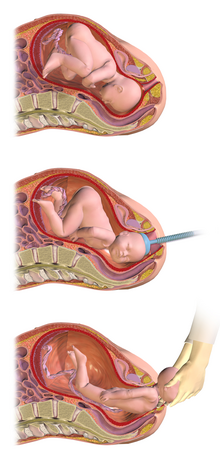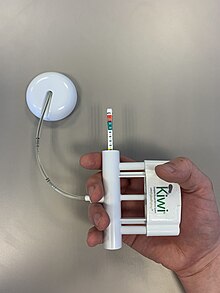

This article needs more reliable medical references for verification or relies too heavily on primary sources. Please review the contents of the article and add the appropriate references if you can. Unsourced or poorly sourced material may be challenged and removed. Find sources: "Vacuum extraction" – news · newspapers · books · scholar · JSTOR (February 2022)
|  |
| Vacuum extraction | |
|---|---|

A baby's scalp showing the effects of a vacuum extraction (chignon). The effects were gone a week later.
| |
| Other names | Ventouse, vacuum-assisted vaginal delivery |
| ICD-9-CM | 72.7 |
Vacuum extraction (VE), also known as ventouse, is a method to assist delivery of a baby using a vacuum device. It is used in the second stage of labor if it has not progressed adequately. It may be an alternative to a forceps delivery and caesarean section. It cannot be used when the baby is in the breech position or for premature births. The use of VE is generally safe, but it can occasionally have negative effects on either the mother or the child.[1] The term ventouse comes from the French word for "suction cup".
There are several indications to use a vacuum extraction to aid delivery:


The woman is placed in the lithotomy position and assists throughout the process by pushing. A suction cup is placed onto the head of the baby and the suction draws the skin from the scalp into the cup. Correct placement of the cup directly over the flexion point, about 3 cm anterior from the occipital (posterior) fontanelle, is critical to the success of a vacuum extraction.[2] Ventouse devices have handles to allow for traction. When the baby's head is delivered, the device is detached, allowing the birthing attendant and the mother to complete the delivery of the baby.
For proper use of the ventouse, the maternal cervix has to be fully dilated, the head engaged in the birth canal, and the head position known. Preferably the operator of the vacuum extractor needs to be experienced in order to safely perform the procedure. The baby should not be preterm, previously exposed to scalp sampling or failed forceps delivery.[1] If the ventouse attempt fails, it may be necessary to deliver the infant by forceps or caesarean section.
In 1849 the Edinburgh professor of obstetrics James Young Simpson, subsequently known for pioneering the use of chloroform in childbirth, designed the Air Tractor which consisted of a metal syringe attached to a soft rubber cup.[1] This was the earliest known vacuum extractor to assist childbirth but it did not become popular.[3] Swedish professor Tage Malmstrom developed the ventouse, or Malmstrom extractor in the 1950s. Originally made with a metal cap, new materials such as plastics and siliconised rubber have improved the design so that it is now used more than forceps.[3][4]
Vacuum delivery as a percentage of vaginal births vary depending on location. In the USA they comprise about 10% to 15% of vaginal births while in Italy 4.8% of vaginal births were delivered via vacuum in 2013.[5]
|
Tests and procedures relating to pregnancy and childbirth
| |||||||||||||
|---|---|---|---|---|---|---|---|---|---|---|---|---|---|
| Maternal tests |
| ||||||||||||
| Fetal tests |
| ||||||||||||
| Interventions |
| ||||||||||||
| Delivery |
| ||||||||||||
| Authority control databases: National |
|
|---|